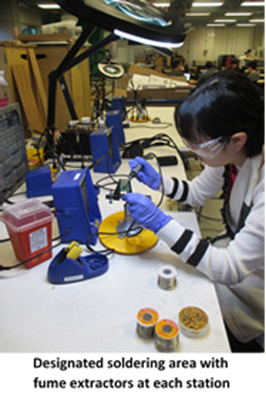Environmental Health & Safety (EH&S) developed the UW Lead Safety Program Manual to help personnel who work with lead materials limit their potential lead exposure to the lowest levels possible. Lead is a potent poison, which may cause significant acute and chronic health effects if not used or handled safely.
Personnel working with lead-containing materials:
- Follow safe work practices, engineering controls and procedures described in the UW Lead Safety Program Manual.
- Wear personal protective equipment (PPE) and respiratory protection when required.
- At a minimum, register for the Lead Awareness online training. Additional training may be required depending on the activity.
- Register lead products/chemicals in MyChem and submit a safety data sheet (SDS).
- Store lead materials as specified in the UW Lead Safety Program Manual.
- Post warning signs in metallic lead use areas and metallic lead storage areas.
- Dispose of lead waste and recycle lead according to the UW Lead Safety Program Manual.
Avoid “take-home” lead. Lead dust on skin, clothes, and in vehicles could be taken home, and unknowingly expose family members. Young children, especially under the age of six, are especially susceptible to the toxic effects of lead, interfering with the development of the nervous system, and are affected at lower exposure levels than adults.
Lead exposures can occur when lead is inhaled as a dust or fume, or accidentally ingested after direct contact or after contact with contaminated surfaces. Lead can affect the heart, nervous system, reproductive system, blood, kidneys and cause digestive problems, memory and concentration problems, and muscle and joint pain. Pregnant women are especially susceptible, as lead can readily pass through the placenta and pose a threat to a developing fetus.
Commonly used lead-containing materials and applications at UW include:
Lead-containing building materials
The most common lead-containing material in buildings is lead-containing paint in older buildings built before 1978. Employees may do repairs and maintenance in buildings that contain lead materials.
Lead-containing products and chemicals
Employees in shops, makerspaces and labs may use lead-containing products such as solder, or work with lead-containing chemicals or items in their research and academic work.
Metallic lead
Researchers, medical personnel, scuba divers and others may use metallic lead as shielding for radiation sources, weights and other applications. Metallic lead is used in many different forms including bricks, sheeting, plates, shot and weights.
Visit the Lead webpage where you will find links to the UW Lead Safety Program Manual and the focus sheets below:
- Lead in Building Materials
- Lead Safety in Shops and Labs
- Metallic Lead Safety
- Lead Safety for Scuba Divers
Contact EH&S Occupational Safety & Health at 206.543.7388 with questions about lead safety.